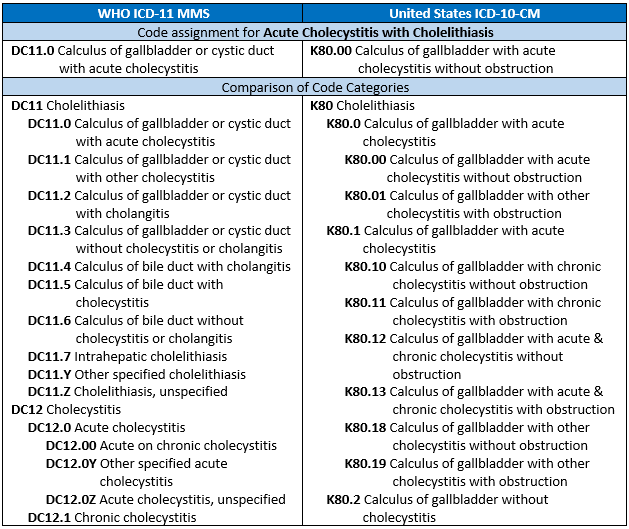Comparing Codes Across ICD Versions: Cholecystitis with cholelithiasis
By: Mary H. Stanfill, MBI, ACHIP, RHIA, CCS, CCS-P, FAHIMA
The WHO ICD-11 classification is very different from the 10th version that the United States modified to create the ICD-10-CM code set that is used for reporting healthcare services on claims in the US today. One distinct difference is ICD-11 codes can be either pre-coordinated or post-coordinated, whereas all ICD-10-CM codes are pre-coordinated.
Let’s compare codes for a common condition, Acute Cholecystitis with Cholelithiasis, to illustrate this difference.

Note:
- These code assignments reflect the closest equivalent code from each code set as of July 2023.
- Code category comparisons reflect excerpts from the ICD-11 MMS Browser compared to segments from the ICD-10-CM Tabular listing
For the last couple of months, we’ve looked at post-coordinated code clusters in the ICD-11 MMS in comparison to pre-coordinated combination codes in ICD-10-CM. But it’s important to keep in mind that the ICD-11 MMS includes both pre-coordinated and post-coordinated codes. The condition coded in the table above is assigned a pre-coordinated code in both code sets as both code systems include pre-coordinated codes to reflect the presence of stones, and either acute or chronic inflammation. However, if we were assigning a code for cholelithiasis with both acute cholecystitis and obstruction, we would need a post-coordinated ICD-11 code cluster. ICD-10-CM includes combination codes with and without obstruction. But the ICD-11 MMS presents a post-coordination option for “Has manifestation” that includes clinical manifestations of the digestive system such as abscess, fistula, obstruction, perforation, etc. As a result, ICD-10-CM has 10 different combination codes for calculus of gallbladder and ICD-11 MMS has 4 codes for calculus of gallbladder.
This coding example illustrates how the specificity of clinical documentation remains important in both code sets to capture all of the details related to the course of the cholelithiasis. Also note the characters Y and Z in ICD-11 compared to the characters 8 and 9 in ICD-10-CM. In ICD-11, the character Y, similar to the character 8 in ICD-10-CM, is used for “other specified” codes. While the character Z in ICD-11, similar to the character 9 in ICD-10-CM, is used for “unspecified” codes. In both code sets these characters should be used less frequently, for example only when more specific clinical documentation cannot be obtained.
Go to the WHO website to browse ICD-11 codes or use the ICD-11 coding tool. It’s fun to browse the ICD-11 hierarchy and look at some of the codes for conditions you code frequently with ICD-10-CM in the US today.
Mary H. Stanfill is Vice President of Consulting for United Audit Systems, Inc. and is the official representative of the IFHIMA to the WHO Family of International Classifications Education and Implementation (EIC) and Morbidity Reference Group (MbRG) workgroups. She has over 35 years of experience in the health information profession, primarily focused on clinical classification of healthcare data. She holds a masters in biomedical informatics and is currently pursuing a doctorate in health informatics.
Email: mstanfill@uasisolutions.com